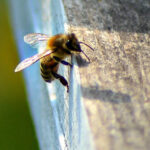Barry Gibb, a name synonymous with the legendary Bee Gees, recently offered a fascinating glimpse into the creation of one of their most iconic disco anthems, “You Should Be Dancing.” As we celebrate the song’s enduring appeal and its 40th anniversary of topping the US charts, we delve into the captivating backstory of this hit, exploring the intricate vocal arrangements that fans often search for when looking up “You Should Be Dancing Bee Gees Lyrics”.
In a recent interview, Barry Gibb shared insights into the meticulous process behind crafting this dance floor classic. The conversation began with a heartwarming family anecdote, linking his musical legacy to the younger generations.
 Barry Gibb of the Bee Gees in 2016, discussing the backstory of 'You Should Be Dancing' and his vocal performance, key elements for fans searching 'you should be dancing bee gees lyrics'
Barry Gibb of the Bee Gees in 2016, discussing the backstory of 'You Should Be Dancing' and his vocal performance, key elements for fans searching 'you should be dancing bee gees lyrics'
The interviewer, Tim Roxborogh, started by referencing a photo of Barry with his son Ashley and grandson Lucas in London, noting the striking family resemblance. Barry fondly recalled the Sony Summer Party where the photo was taken, highlighting his grandson Lucas’s surprising dance prowess. This jovial family moment served as a perfect segue into discussing “You Should Be Dancing,” a song that inevitably gets everyone moving.
Roxborogh then smoothly transitioned to the song’s 40th anniversary of reaching number one in the US charts in September 1976. He touched upon the intriguing details surrounding the recording, such as Stephen Stills’s contribution on percussion and the impressive layering of percussion tracks. He prompted Barry to share some memorable moments from the recording sessions.
Barry Gibb reminisced about the painstaking effort invested in perfecting “You Should Be Dancing.” He revealed that the track was recorded at least four times, with constant refinements over a two-week period. He vividly recalled Stephen Stills playing percussion in the early hours of the morning, emphasizing the exploratory and innovative atmosphere in the studio. Living in Miami at the time, the Bee Gees were immersed in Latin rhythms, which naturally influenced the song’s rhythmic complexity. This fusion of influences contributed to the unique sound that makes listeners search for and appreciate even the “you should be dancing bee gees lyrics” in a new light, understanding the vibrant musical landscape that birthed them.
Roxborogh praised the song’s intricate details, mentioning his recent discovery of Barry’s falsetto vocals accompanying the trumpet solo, a detail often missed when listening to the full mix. He credited YouTube for allowing listeners to isolate the vocal tracks, unveiling hidden gems within the song’s arrangement.
Barry elaborated on their experimental approach in the studio, driven by the newfound freedom of multi-track recording. He mentioned adding vocal explosions to “Tragedy” and instrumental vocalizations in “Jive Talkin’,” all in pursuit of sonic novelty. “You Should Be Dancing,” he explained, benefited from this approach, with layers of unexpected elements enhancing its distinctiveness. He highlighted the collaborative mixing process, involving ten people simultaneously manipulating faders on the mixing board. Barry’s specific role was controlling the echo repeat on the line “Whatcha’ doin’ on ya’ back?”, a vocal hook that fans often sing along to, demonstrating the importance of even seemingly minor lyrical phrases when considering “you should be dancing bee gees lyrics”.
The interviewer playfully mimicked the echoed line, acknowledging Barry’s crucial role in creating that signature sound. Barry chuckled, confirming it was indeed his designated task during the live mix. He emphasized the pressure of the analog mixing process, where mistakes required restarting the entire mix from scratch due to the lack of digital saving capabilities.
Roxborogh then shifted the conversation to the hit potential of “You Should Be Dancing.” He inquired if the Bee Gees had a sense during the mixing process that they were creating a smash hit. Barry responded that while predicting chart success is never certain, they recognized the song’s special quality. He recalled feeling a similar certainty with “Islands In The Stream” and “How Deep Is Your Love,” but “You Should Be Dancing” was driven by a different inspiration. It was born from the desire to create music that mirrored the burgeoning dance craze, aiming to make a record that would compel everyone to move.
Barry drew a parallel to Paul McCartney’s ambition to emulate the Beach Boys with “Here, There And Everywhere,” suggesting that “You Should Be Dancing” was similarly inspired by a desire to capture a particular musical spirit. However, he distinguished “How Deep Is Your Love” as a more original creation, not directly influenced by another artist.
In conclusion, Barry Gibb’s reflections provide a rich context for appreciating “You Should Be Dancing” beyond just its infectious rhythm. Understanding the meticulous recording process, the innovative mixing techniques, and the vocal intricacies, especially when considering the “you should be dancing bee gees lyrics,” enhances our appreciation for this disco classic and solidifies its place in music history. It’s a testament to the Bee Gees’ artistry and their ability to craft songs that continue to resonate and inspire dance across generations.

